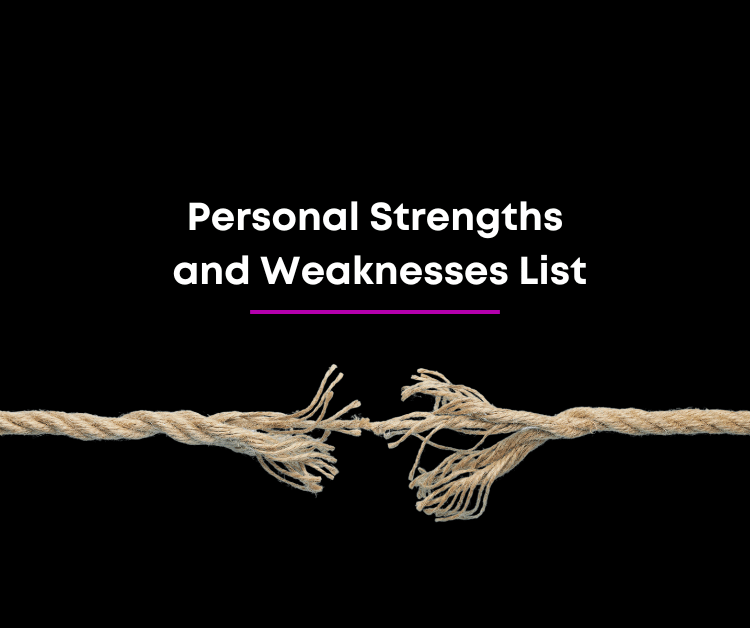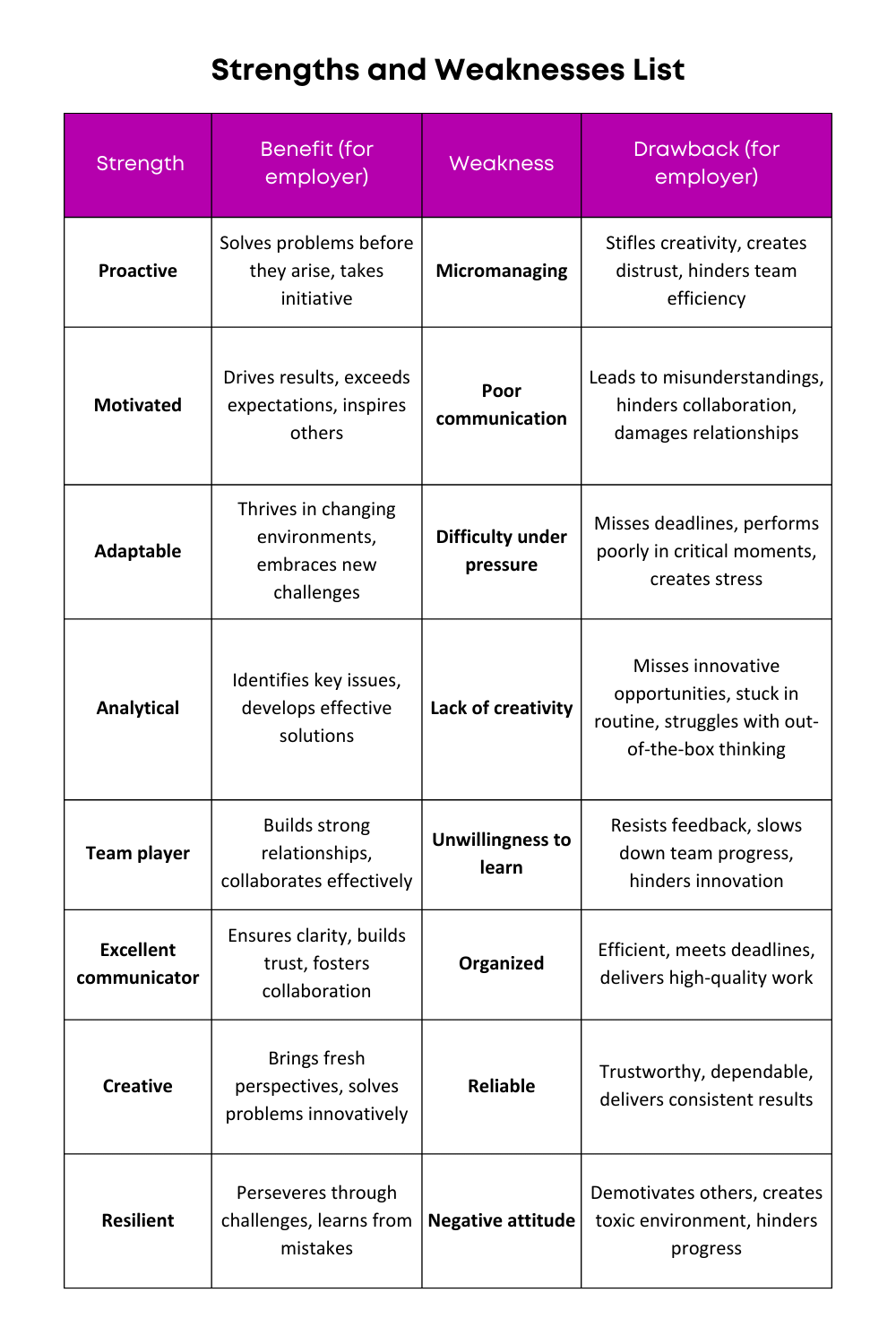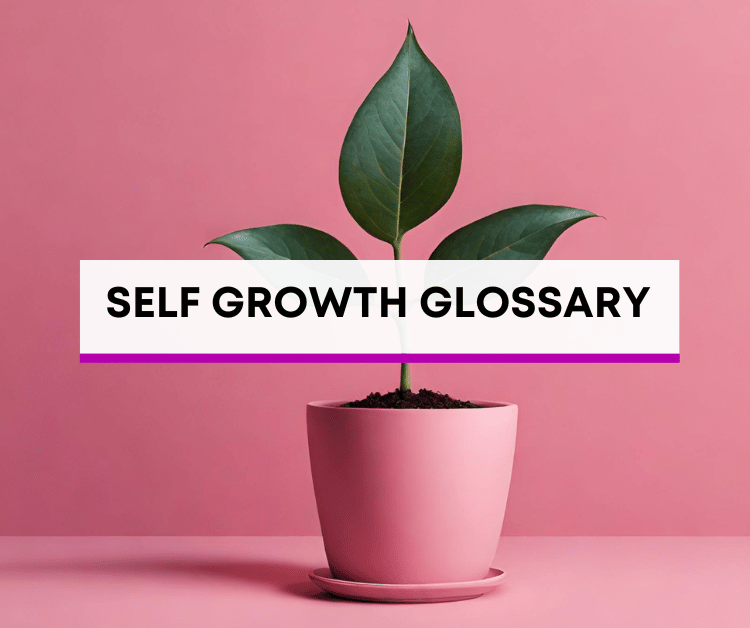
A personal strengths and weaknesses list isn’t just handy for work – it’s a game-changer in any situation.
Identify the words that really speak to you, and we’ll guide you on what to do next once you’ve pinpointed your key traits.
This post will showcase a personal strengths and weaknesses list. Plus, we will show you how to use it effectively.
Personal Strengths and Weaknesses List

Personal Strengths Words List
- Adaptability
- Analytical Skills
- Assertiveness
- Attention to Detail
- Creativity
- Critical Thinking
- Decision-Making
- Emotional Intelligence
- Empathy
- Flexibility
- Initiative
- Innovativeness
- Leadership
- Motivation
- Organizational Skills
- Perseverance
- Positive Attitude
- Problem-Solving
- Resilience
- Strategic Thinking
- Teamwork
- Time Management
- Communication Skills
- Self-Motivation
- Adventurousness
Personal Weakness Words List
- Procrastination
- Impatience
- Perfectionism
- Lack of Confidence
- Poor Time Management
- Overcommitting
- Conflict Avoidance
- Difficulty Delegating
- Resistance to Change
- Inability to Take Criticism
- Indecisiveness
- Overthinking
- Fear of Failure
- Lack of Focus
- Inflexibility
- Overemphasis on Details
- Difficulty Saying No
- Defensiveness
- Micromanaging
- Discomfort with Confrontation
- Difficulty in Handling Ambiguity
- Insecurity
- Lack of Emotional Intelligence
- Tendency to Blame Others
- Difficulty Setting Boundaries
Strengths and Weaknesses Stats
Strengths: Top self-reported:
- Creativity (44%) – Source: CareerBuilder 2023 Skills Report
- Problem-solving (40%) – Source: CareerBuilder 2023 Skills Report
- Communication (38%) – Source: CareerBuilder 2023 Skills Report
- Adaptability (36%) – Source: LinkedIn 2023 Global Talent Trends Report
- Teamwork (35%) – Source: LinkedIn 2023 Global Talent Trends Report
Most sought-after by employers:
- Communication (82%) – Source: LinkedIn 2023 Global Talent Trends Report
- Teamwork (78%) – Source: LinkedIn 2023 Global Talent Trends Report
- Problem-solving (75%) – Source: LinkedIn 2023 Global Talent Trends Report
- Adaptability (72%) – Source: Indeed 2023 Emerging Jobs Report
- Critical thinking (69%) – Source: World Economic Forum 2023 Future of Jobs Report
Gender differences:
- Women: Empathy, detail-orientation, communication – Source: Harvard Business Review 2021 “Women in the Workplace” survey
- Men: Problem-solving, leadership, decisiveness – Source: Pew Research Center 2022 “Gender Roles” survey
Weaknesses Commonly admitted:
- Public speaking (25%) – Source: Toastmasters International 2023 Global Speech Anxiety Survey
- Procrastination (22%) – Inc. Magazine 2023 “Most Common Productivity Mistakes” article
- Time management (20%) – ADP Research Institute 2023 “Time Management Challenges” report
- Dealing with pressure (18%) – American Psychological Association 2023 Stress in America report
- Delegating tasks (17%) – Harvard Business Review 2022 “Delegation Dilemmas” article
Most concerning for employers:
- Poor communication (42%) – LinkedIn 2023 Global Talent Trends Report
- Lack of motivation (37%) – Gallup 2023 State of the American Workplace report
- Difficulty under pressure (35%) – Korn Ferry 2023 Executive Stress Survey
- Poor teamwork skills (32%) – Forbes 2023 “Top 5 Soft Skills Employers Look For” article
- Lack of critical thinking (30%) – World Economic Forum 2023 Future of Jobs Report
Generational differences:
- Gen Z: Technology dependence, fear of failure, social anxiety – Source: Deloitte 2023 Global Gen Z Survey
- Millennials: Work-life balance, perfectionism, fear of missing out – Source: Pew Research Center 2021 “Millennials in America” report
- Gen X: Difficulty asking for help, delegating tasks, adapting to change – Source: Center for Generational Kinetics 2023 “Generations at Work” study
How to Talk About Your Strengths and Weaknesses
When talking about yourself professionally, highlight your strengths by aligning them with the job requirements, providing specific examples of achievements and experiences that showcase your capabilities.
*As an Amazon Associate, we earn from qualifying purchases at no additional cost to you.
For weaknesses, focus on those you’ve actively worked to improve, demonstrating a commitment to personal and professional growth. Here are some bullet point examples:
Strengths:
- Effective Communication: Led successful team meetings, improving information flow.
- Problem-Solving: Implemented a streamlined process that increased efficiency by 20%.
- Adaptability: Successfully transitioned between multiple projects with varying scopes.
- Teamwork: Collaborated with cross-functional teams to achieve project milestones.
- Time Management: Consistently met project deadlines by prioritizing tasks effectively.
Weaknesses:
- Public Speaking: Attending Toastmasters to improve confidence and delivery.
- Procrastination: Implemented time-blocking techniques for better task prioritization.
- Time Management: Utilizing project management tools to enhance efficiency.
- Delegating Tasks: Actively seeking mentorship to improve delegation skills.
- Handling Pressure: Participated in stress management workshops for better coping strategies.
Conclusion
To sum it up, if you haven’t started exploring your strengths and weaknesses, let’s keep it simple.
Pick one strength that feels true to you and one weakness you’re ready to work on.
This straightforward approach is a practical way to begin your journey of self-reflection and improvement.
By focusing on just these two aspects, you’re setting the stage for personal growth.
So, without overthinking it, choose one strength and one weakness. Let this easy step be the beginning of positive change in your life.
You’re taking the first steps towards a more self-aware and resilient you.
Keep it simple and embrace your transformative potential!
FAQS- Strengths and Weaknesses List
Why create a strengths and weaknesses list?
- A list helps identify your key attributes, enabling better self-awareness for personal and professional growth.
How do I identify my strengths?
- Reflect on activities where you excel, seek feedback from others, and consider what energizes and motivates you.
What’s the purpose of identifying weaknesses?
- Recognizing weaknesses allows for targeted improvement, fostering a proactive approach to personal development.
Can strengths and weaknesses change over time?
- Yes, they can evolve based on experiences, learning, and personal growth.
How many strengths and weaknesses should I list?
- Start with a few, perhaps one or two strengths and one or two weaknesses, to keep the process manageable and focused.
Should I tailor my list for different contexts?
- Yes, consider the specific requirements of different situations, such as work, personal relationships, or self-improvement goals.
How often should I update my strengths and weaknesses list?
- Regularly review and update your list to reflect changes in your skills, experiences, and self-perception.
What if I struggle to identify weaknesses?
- Seek honest feedback from peers, mentors, or self-assessment tools to gain a more objective perspective.
How can I leverage my strengths at work?
- Align your strengths with tasks and responsibilities, share them with colleagues, and use them as talking points during performance evaluations or job interviews.
What’s the best way to address weaknesses in a professional setting?
- Acknowledge them openly, showcase efforts to improve, and actively seek opportunities for skill development.



